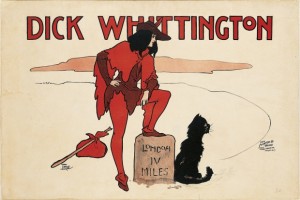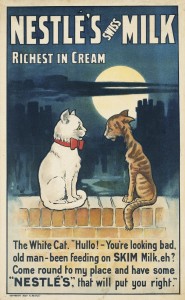At the end of the 19th century, the publicity poster reached a renowned level of popularity, becoming one of the main emblems of the modern society. The major commercial brands supported the development of posters, aware of the possibilities that, for the diffusion of the advertising message, they offered a very attractive visual resource. The street became the setting where the public could contemplate the new artistic productions without the need to keep up an attitude of contemplative predisposition. Chance, the unexpected or sudden encounter, or the stimulus of the capacity to surprise were aspects which were to go on to form part of the new urban landscape. With the aim of managing to catch the attention of passers-by, the artists didn’t hesitate to use an iconographic repertoire which was much closer to the everyday reality, making use of eye-catching typography and a highly varied chromatic range.
The iconography of the cat
During this period, the posters frequently used the image of cats for many of the advertising campaigns. Considered one of the quintessential pets, they became a major protagonist, either because they awoke feelings of friendliness which were very generalised, or because they would be considered, especially the black ones, a reference of artistic modernity. In this last sense, cats became established as the icon of the Parisian Le Chat Noir, founded by Rodolphe Salis and whose inauguration in 1881 represented a milestone in the history of European culture, by becoming the meeting place of the artistic Bohemia of the time.
In reality, under this innocent appearance, there was a hidden desire to pay tribute to the North-American writer Edgar Allan Poe, recognised as one of the forerunners of modernity and author of the famous tale of terror, The Black Cat, published in 1843 in the newspaper, the Saturday Evening Post of Philadelphia. It should be remembered that the French poet Charles Baudelaire, in his condition of translator to French of the work of Poe, was one of the authors who contributed most to its diffusion.
Years later, Aristide Bruant, the cabaret singer, poet and one of the most popular figures of Bohemia Paris, would connect with the whole of this long cultural tradition and in a short poem, entitled Le Chat Noir, wanted to vindicate the symbolic validity of the black cat.
Within this context, it is easy to understand the proliferation of images of black cats that filled the posters of the time. For many authors their inclusion was a sort of was intentioned nod towards one of the most emblematic motifs of modern culture.
The opening in Barcelona of the tavern of the Els Quatre Gats (1897), founded by Pere Romeu, can be understood as the result of the attempt to move the ambience of the famous Parisian venue to the city.
Related links
Catalogue: Toulouse-Lautrec and the Origins of Modern Poster
Catalogue: El cartell modern a les col·leccions del Museu Nacional d’Art de Catalunya
Gabinet de Dibuixos i Gravats













